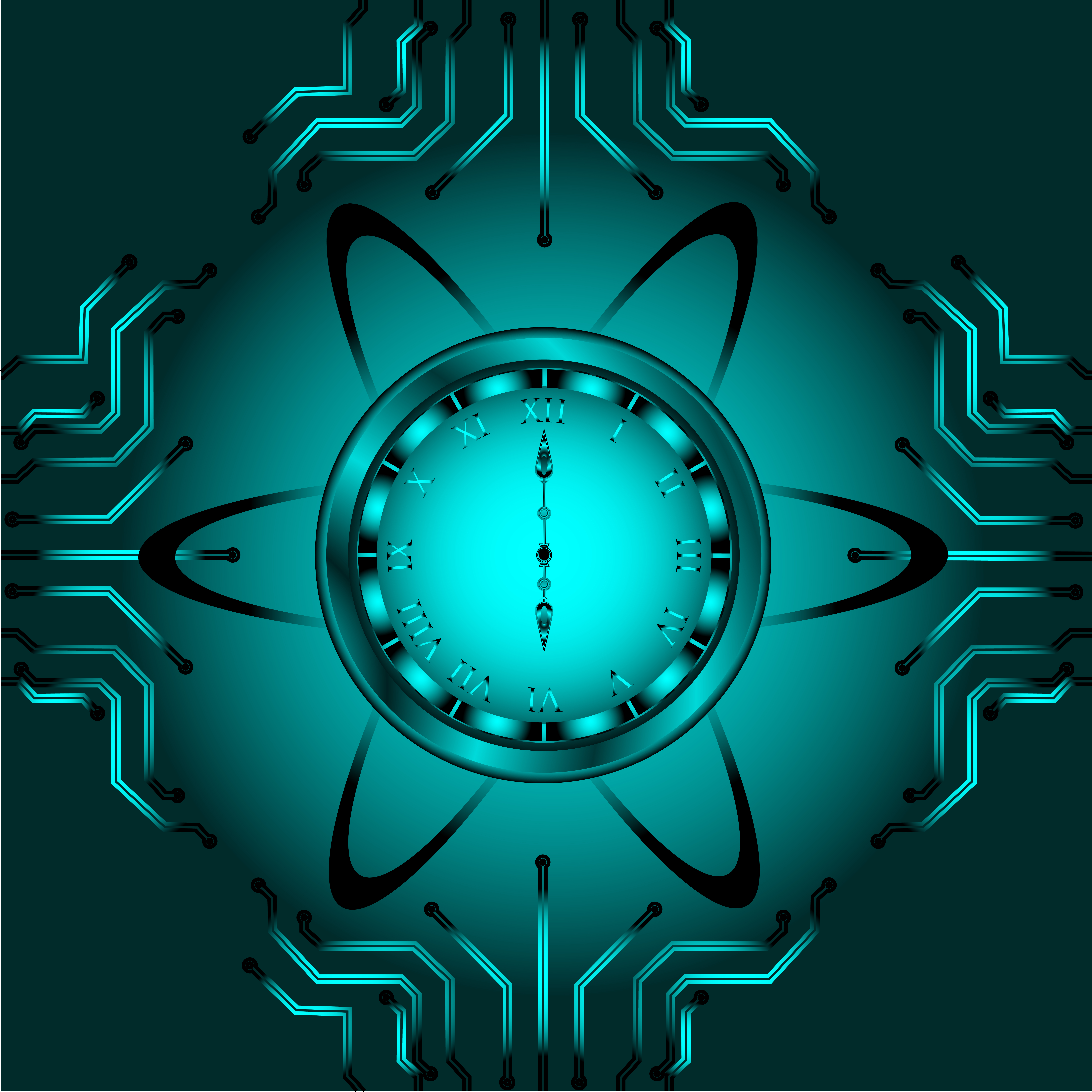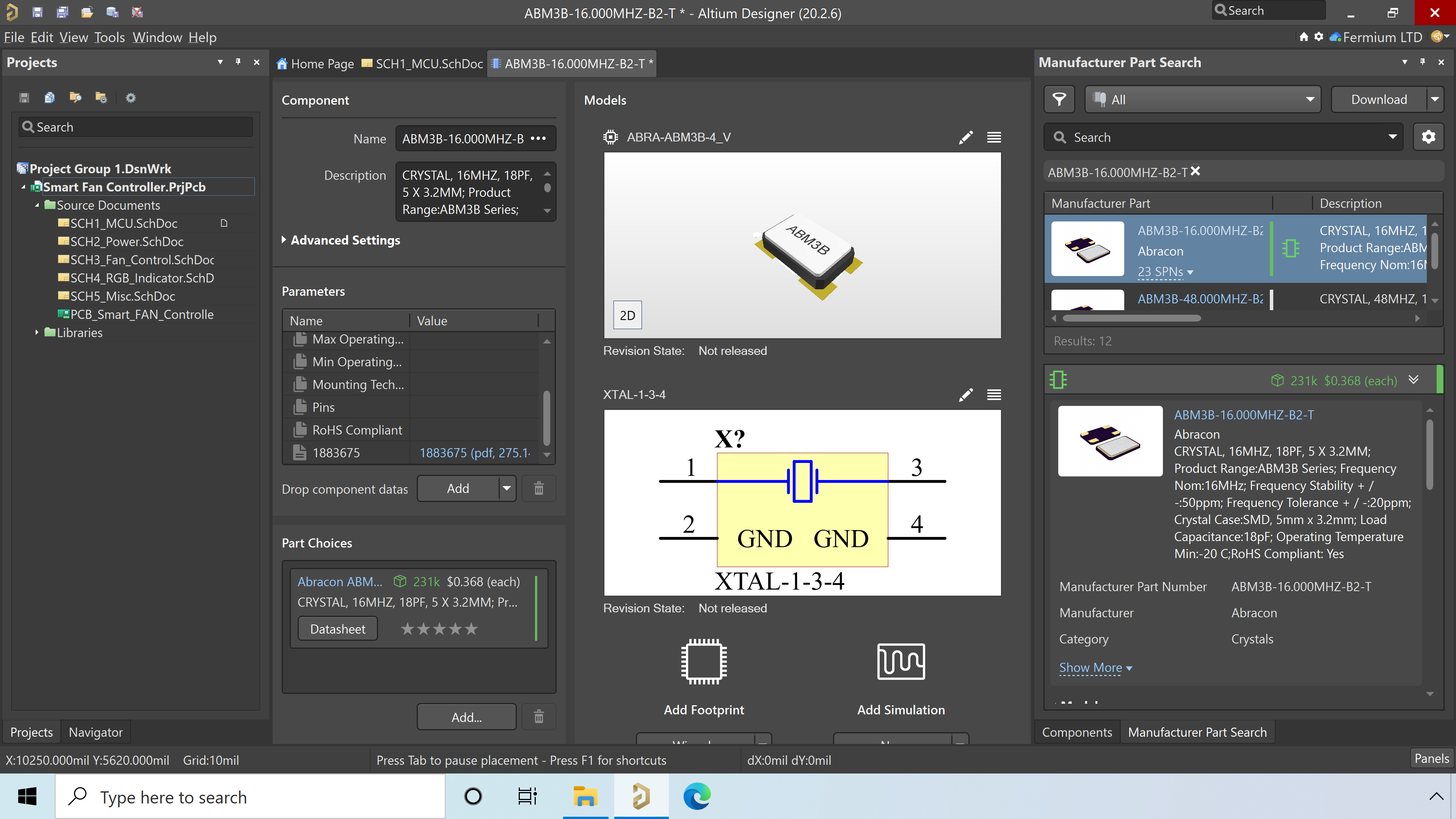From RC to Atomic Clocks: All Clock Sources

In almost modern circuits, especially whenever digital circuitry is involved, you will find some kind of clock source. All clock sources present a series of tradeoffs regarding stability, reliability, size, power consumption and cost.
Luckily for us, such tradeoffs are relatively simple and can be explained almost fully within this single article. We’ll discuss the pros and cons of each clock source, from the RC in a 555-powered oscillator, to a Hydrogen Maser atomic clock.
Let’s get started!
Relaxation and Delay Sources
RC Relaxation
Relaxation oscillators are made of a switching device (usually BJTs, JFETs, Mosfets, or digital gates) and a capacitor to store charge. The capacitor is charged up to a defined voltage level, then the state of the device changes and the capacitor is discharged. The circuit oscillates between the charging and the discharging state.
Relaxation oscillators do not produce sinusoidal signals. Instead, they produce sawtooth signals and square waves.
A typical example of the RC relaxation oscillator is the famous NE555. Parameters for this type of oscillator can be found below.
| Parameter | Value |
| Stability (lower is better) | 10^-2 to 10^-3 |
| Tunability | over 10:1 |
| Frequency range | Hz to 10’s Mhz |
| Cost | Extremely low |
Delay and Phase-Shift Oscillators
The requirement to get an analogue circuit to oscillate is a 180-degrees phase shift at unity gain in a feedback loop. A series of RC elements can shift the phase of a signal to the necessary 180-degrees shift to achieve oscillation.
You can obtain the same effect with any device that provides an adequate delay in the signal, for example, a bunch of NOT ports in series or a spool of wire that’s long enough to do the job.
Delay oscillators usually have inferior stability when compared to other types of oscillators, so much so that semiconductor manufacturers use them to test wafers, as their performance is heavily temperature dependent.
Often times, NOT ports connected in series are so unstable that you can use the frequency fluctuations of the oscillator as a true random number generator.
| Parameter | Value |
| Stability (lower is better) | 10^-2 to 10^-3 |
| Tunability | 10:1 or less |
| Frequency range | 10Mhz to 100’s Mhz |
| Cost | Extremely low when part of another IC |
Resonators
When considering relaxation and delay sources, the higher their nominal frequency is, the more impractical the design becomes.
A resonator is a device or system that exhibits resonant behaviour, oscillating with higher amplitude at some frequencies.In many kinds of resonators, these frequencies tend to be relatively narrow and stable, making them excellent oscillators.
Resonators can resonate due to their electrical properties (for example, LC resonators), electromechanical properties (for example, ceramics, crystals, and MEMS), electromagnetic wave propagation, or even atomic properties for atomic clocks.
Almost everything can be a resonator, from skyscrapers to your lung cavity. If you so desire, you could use a pendulum as your next clock source, but for this article, we’ll limit the scope to resonators widely used in the electronic industry to generate a clock signal.
LC Resonators
LC resonators used to be the most widely adopted kind of oscillators when the world ran on wireless radios that were under a few hundred megahertz.
They consist of some sort of LC network connected to an amplifier, with the amplifier providing positive feedback. The most common types of LC oscillators are Colpitts and Hartley.
LC resonators are only modestly tunable. Early radios used variable inductors or variable capacitors, but if your goal is to tweak the frequency electronically, the only practical way is to change the ‘C’ in LC. The trick is to use a reversely-polarised diode junction exhibiting a voltage-dependent reverse-bias capacitance.
Specially designed diodes, called varactors, are tuned to cover up to a 15:1 ratio in capacitance. A varactor can be transformed into an excellent voltage-to-capacitance converter by placing a capacitor in series with it to eliminate the DC reverse bias current.
| Parameter | Value |
| Stability (lower is better) | 10^-3 to 10^-5 |
| Tunability | modest |
| Frequency range | Khz to 100’s Mhz |
| Cost | low |
Crystals/XTAL
RC oscillators with well-selected components can have a stability of 0.1%. LC oscillators fare a bit better, around 0.01%. Crystals can do much, much better, as we’ll see shortly.
The functionality of crystal oscillators is thanks to the piezoelectric effect and the resulting inverse piezoelectric effect. When a piezoelectric material is mechanically stimulated, it produces an electric signal. Vice-versa, an electric stimulation in the same material will generate mechanical movements.
If a piezoelectric material is cut in an appropriate shape and two electrodes are applied to it, it’s possible to create a sound wave by stimulating it electrically. The sound wave will propagate back and forth, generating a voltage as well. The piezoelectric effect was first documented in the mid-18th century.

A crystal oscillator can, in general, be modelled electrically as a resistance, an inductance, and a capacitor in series, with a further capacitor in parallel to the RLC series due to parasitic capacitance of the plated contacts and the component leads.
All crystals have not one resonant mode, but two: series and parallel.
In series-resonant mode, C1 and L1 resonate, and C0 is not involved in the process. In parallel-resonant mode, C0 and C1 resonate together with L1.
Whenever you use an IC that requires a crystal oscillator, you should verify if the manufacturer has specified what resonant mode the part is specified for, series or parallel. Their resonant frequencies will differ.
In parallel-resonant mode, you can alter the value of C0 by placing a second capacitor in parallel. VCXO, or voltage-controlled crystal oscillators, are often created with a varactor in parallel to the main crystal.
| Parameter | Value |
| Stability (lower is better) | 10^-5 |
| Tunability | 10^-4 |
| Frequency range | 10’s Khz to 10’s Mhz |
| Cost | medium |
Ceramic Resonators (not to be Confused With SAW Oscillators)
Similarly to crystals, ceramic resonators are piezoelectric devices, but instead of being made of quartz, they’re made of ceramic.
Ceramic resonators have similar electric properties to quartz oscillators as well, but are less precise (typically 0.3% initial frequency accuracy) and have poor stability (0.2-1% over time and temperature). The good news? They’re dirt cheap!
Ceramic resonators fill an otherwise empty niche between crystal oscillators and RC, and are often electrically compatible with the former.
| Parameter | Value |
| Stability (lower is better) | 10^-5 |
| Tunability | 10^-4 |
| Frequency range | 10’s Khz to 10’s Mhz |
| Cost | low-medium |
TCXO
Temperature Compensated Cristal Oscillators (TCXO) are an improvement over standard crystals and are often necessary when you need stable frequency over a wide temperature range, for example over industrial or automotive temperature ranges, especially when using an RTC (Real Time Clock).
They include active circuitry that compensates for the temperature deviation of the frequency, usually by using the parallel resonant mode and changing the capacitance of the parallel equivalent capacitor C0 with a varactor, as described previously.
The fancier models include a microprocessor, analogue-digital circuitry and a lookup table, and can present down to 1ppm of frequency shift over ten years.
| Parameter | Value |
| Stability (lower is better) | 10^-6 to 10^-7 |
| Tunability | 10^-4 |
| Frequency range | 10’s Khz to 10’s Mhz |
| Cost | medium |
OCXO
Oven-Controlled Crystal Oscillators (OCXO), can achieve the highest frequency stability possible with a crystal oscillator, indeed the highest frequency stability possible without recurring to atomic sources in one form or another.
In an OCXO, a particular kind of crystal that presents a null temperature coefficient at one specific temperature, usually between 80 and 90 degrees celsius, is kept heated by an electronically-controlled oven. In this way, the temperature coefficient is nulled in two different ways: by stabilising the temperature as much as possible and by operating in a regime where it’s zero in the first place.
OCXO, especially the bigger ones that can afford some extra thermal insulation, are so good at correcting the temperature deviations that the primary remaining error is crystal ageing. Some OCXOs even incorporate a microcomputer to compensate for the ageing using sophisticated algorithms; however, they will always be subject to drift due to mechanical shocks and other unpredictable physical stimuli.
The downside of using OCXOs is the high cost and elevated temperature consumption due to the heater.
| Parameter | Value |
| Stability (lower is better) | 10^-8 to 10^-9 |
| Tunability | 10^-4 |
| Frequency range | 10Mhz typically |
| Cost | high |
MEMs
MEMs, or micromechanical devices, are usually manufactured from silicon using processes similar to those used in integrated circuit manufacturing.
Currently, the smallest crystal oscillator is FCX-08 by River Electronics, at 1.2×1.0mm. Even if the crystal inside is smaller, to maintain good specifications over time crystals require protection from environmental contamination and air through sealed packaging, either by soldering (for the “big and cheap” moels) or by electron beams welding (smaller but more expensive).
MEMs oscillators can be much smaller than crystal oscillators. Latest generation iPhones use Mems oscillators manufactured by SiTime, measuring just 0.42x0.42mm and available in wafer-level packages.
MEMs often have lower power consumption than crystal oscillators as well.
| Parameter | Value |
| Stability (lower is better) | 10^-5 |
| Tunability | 10^-4 |
| Frequency range | 10’s Khz to 10’s Mhz |
| Cost | high |
SAW
Surface acoustic wave (SAW) oscillators work somewhat similarly to crystal oscillators. Instead of a bulk wave that flexes and moves the whole crystal, SAW oscillators use surface waves. They usually have an input transducer and an output transducer, and behave somewhat like analogue delay lines.
SAW are usually manufactured in ceramic and not quartz, although quartz models have been known to exist as well.
SAW can reach frequencies of up to hundreds of MHz, much higher than the tens of megahertz of crystals.
SAWs can be a viable low-cost clock source for common RF frequencies such as 433Mhz. Less-common values tend to be more expensive, often more than a crystal and a PLL IC.
| Parameter | Value |
| Stability (lower is better) | 10^-4 |
| Tunability | 10^-4 |
| Frequency range | 100’s Mhz |
| Cost | medium |
Cavity Resonators
Cavity resonators are typically used at microwave frequencies, and the most common example is the cavity magnetron present in microwaves.
Their use is restricted to high-power RF applications, so we will not discuss them further.
| Parameter | Value |
| Stability (lower is better) | 10^-5 |
| Tunability | only mechanical |
| Frequency range | Ghz to 10’s Ghz |
| Cost | high |
Dielectric Resonators
Dielectric resonators are pieces of dielectric materials, usually barium titanate or a similar ceramic, and are used to replace cavity oscillators. You can glue dielectric resonators to RF PCBs similarly to surface mount components. They’re used, for example, in the popular HB100 Doppler module.
| Parameter | Value |
| Stability (lower is better) | 10^-4 |
| Tunability | only mechanical |
| Frequency range | Ghz to 10’s Ghz |
| Cost | medium |
Atomic Clocks
If an OCXO crystal oscillator doesn’t cut it in terms of stability and precision, atomic clocks can be smaller and more affordable than you might realise.
Rubidium
Rubidium atomic clocks are the most affordable atomic clocks available. A rubidium discharge lamp (similar to a small mercury lamp, like those that light the street) will drop it’s light output by about 0.1% when it’s rubidium vapour is exposed to an electromagnetic field at a frequency close to that of its hyperfine transition, 6.834,682,612 GHz.
The frequency of the microwave field is synthesised from the 10Mhz crystal oscillator present in every rubidium clock. When the light dips, the microcontroller knows the frequency is precisely 6.834,682,612 GHz and can correct the crystal oscillator accordingly.
Rubidium clocks have become smaller and smaller over the years, and are now available in packages similar to DC-DC converters and weights of just over 30g.
| Parameter | Value |
| Stability (lower is better) | 10^-10 |
| Tunability | - |
| Frequency range | 10Mhz only |
| Cost | 200-2000USD |
GPS/GNSS Disciplined Oscillators
The GPS receiver present in your phones works by carefully comparing the arrival time of signals from different satellites and triangulate its own position.
To achieve such a feat, the satellites must have extremely precise atomic clocks on board. The GPS satellites usually have Rubidium Atomic Clocks, while the more modern Galileo system has a combination of redundant Hydrogen Maser and Rubidium Atomic Clocks and can achieve even higher stability.
In both cases, the signals from the satellites are compared by teams of experts to networks of atomic clocks on the ground and corrected multiple times a day.
As such, the GPS system has incredible long-term stability. Unfortunately, due to atmospheric interference the short-term stability is not as good.
TXCO, and OCXO, often with a rubidium fail-back, can be synced to the GPS signal to achieve a combination of short-term and long-term stability, at a reasonably low cost.
Additionally, the GPS will provide you with the date and time, not only the time-keeping clock signal, thus working as both a clock and an RTC (Real Time Clock).
| Parameter | Value |
| Stability (lower is better) | 10^-13 (long term) |
| Tunability | - |
| Frequency range | 10Mhz only |
| Cost | 50-2000USD |
Caesium, Hydrogen Maser and Other Expensive Atomic Clocks
A Hydrogen Maser will likely set you back over a hundred thousand dollars, but Cesium Atomic Clocks have become cheaper and are now routinely found in many reasonably-sized data centers. Many data centers can not use GPS disciplined oscillators, as they’re sensitive to jamming and could stop operating if the US were to declare war.
Hydrogen Maser is the only “real and direct” oscillator among all the commercially available atomic-clocks, and as such are extremely reliable in the short term as well, while Cesium and Hydrogen still need to have some kind of secondary oscillator inside synced to the primary time reference.
| Parameter | Value |
| Stability (lower is better) | 10^-14 for H Maser |
| Tunability | - |
| Frequency range | 10Mhz only |
| Cost | 5000-500000USD |
Conclusions
We’ve discussed all available clock sources in the market. Hopefully, this article left you with a better understanding of the pros and cons of each solution.
Clock sources are the rare kind of components whose choice can have deep implications on the stability and performance of your system, especially when you are integrating multiple sub-circuits from a single clock signal, or communicating with external resources. For example, any modern device that communicates through encrypted protocols such as TLS, or other private/public key encryption scheme, must have accurate timekeeping. Lose it, and your device will not be able to communicate with the servers anymore.
Similarly, imprecise RC clocks in digital analogue designs can alter the performance of connected ADCs and DACs, in particular SAR (Successive Approximation Registrater) ADCs and Delta-sigma ADCs and DACs.
In addition, clock sources can often be fickle devices. Use the wrong capacitor to compensate a quartz crystal, or simply choose one with a high temperature coefficient, and your device will oscillate between broken and unreliable.
Precisely selecting and tracking components, ensuring only the appropriate oscillator and appropriate capacitor is fit to your boards is of the utmost importance. To achieve this, you need to do two things.
- Ensure proper revision and release management of your projects.
- Ensure that each component is adequately identified in the BOM.
Concord Pro®, in particular when hosted in Altium 365® with full-access to Octopart’s data, takes care of both.
In this example, I searched one of my favourite crystals, Abracom’s ABM3B-16.000MHZ-B2-T in the Manufacturer Part Search panel’s (bottom right corner in Altium Designer®). As you may have observed, the component already includes footprint, symbol, datasheet, full descriptions, and manufacturer and manufacturer part number. With three clicks (right-click, acquire, OK) the component can be imported into your Concord Pro server and join his brothers and sisters in your library.

The component placed on your schematic will now be identified by a single Manufacturer/MPN pair. If you desire to add more alternative parts, this can be done through the Part Choices section while editing the component.
Your project will need to be managed as well to ensure full traceability as discussed in a previous article. In this example, migrating Mark Harris’ Fan Controller project to the cloud takes only a couple of clicks.
The design tools in Altium Designer® contain everything you need to keep up with new technology. Talk to us today and find out how we can enhance your next PCB Design.
